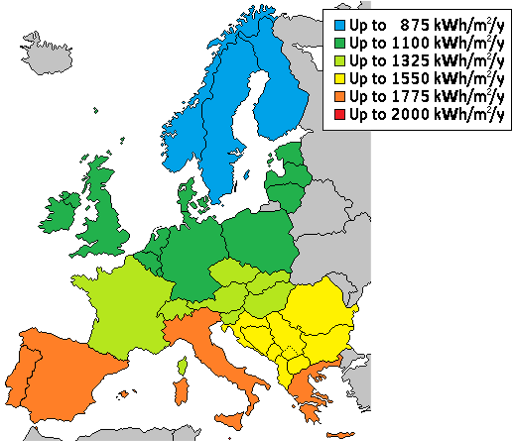Solar energy
Published on 10 January 2022
Solar energy reaches ground level either as direct sun irradiation or as light scattered by the atmosphere (cloud, moisture, particle, reflection). Local climate defines light scattering: minimal in deserts, large in overcast conditions. Depending on location, time and climate, the relative weight of direct and indirect irradation varies.
Solar energy can either directly transformed into electricty with a photovoltaic panel (PV) or indirectly through heat storage in a Concentrated Solar Powerplant (CSP). While CSP can only capture direct irradiation, PV panels can harvest both direct sun irradiation and scattered light.
Solar energy is by definition a highly variable renewable energy with a temporal variation that is a combination of daily and seasonal influences. The day-night cycle prevents energy harvesting for more than half the time. Seasonal variation includes a variation in daylight as well as a variation of sun angle, both lowering the recoverable energy in winter.
Resources in Europe
In Europe, location mainly acts on possible sun energy harvesting through latitude with higher latitude countries experiencing more daylight variation with seasons and a sun angle further away from the vertical. Local climate also defines the degree of light scattering. A more humid climate with frequent overcast induces more scattering. Combination of latitude and climate drives the map of available energy: large in Southern Europe, weaker in Northern Europe.
Note that such variations are not exclusively linked to Europe: in Asia, at the same latitude, the Middle-East will experience mainly direct sun irradiation, while light scattering due to atmospheric humidity will be more important in the Far East.

Map of sun irradiation intensity in Europe
Photovoltaic panels
Photovoltaic (PV) panels can convert both direct and indirect sun light into electricity, making them a convenient solution across Europe. Their orientation can be adapted to latitude, to seasons (monthly reorientation) or even instantaneously (sun tracking).
Efficiency of commercial PV is 15 to 22%, under standard test conditions with cells kept at 25°C. Critically, intense sun exposure is adverse because irradiation heats up the panel and efficiency of PV cells decreases with temperature (loss of 0.25 to 0.5% per degree Celsius). On a sunny day with 25°C ambient air, PV cells are at least at 45°C, shaving off up to 10% of their base efficiency.

Schematic of solar energy harvesting with solar panels
As Northern Europe has a colder climate, the effect of temperature partially counter-balances the weaker sun exposure. The European map of PV potential is therefore less skewed towards Southern Europe than the irradiation map.
Concentrated Solar Powerplant
Renewable electricity from solar energy does not have to be a daytime resource. Solar energy can be transformed into a base load renewable electricity resource with a Concentrated Solar Power (CSP) unit.
CSPs convert direct sun irradiation into heat. Heat can then either be stored or converted into electricity in a conventional steam turbine system running on a Rankine cycle. Electricity generation is identical to that of coal, gas or nuclear power plants, but without the environmental drawbacks.
CSPs use reflectors or troughs to concentrate irradiation on collectors filled with a heat transport fluid. Hot fluid can be routed towards either a storage tank or the steam heater.

Schematic of a Concentrated Solar Powerplant using trough for heat collection
Efficiency of heat generation is restricted by the achievable temperature gap between the hot tank and the fluid coming back to the collectors. With existing molten sand technology, a reasonable efficiency is ~40%. Combined with ~40% efficiency for the electricity generation side, global efficiency from solar energy collection to electricity is around 15%.
As CSPs only collect direct sun irradiation, they only suit locations where cloud cover is rare, i.e. mostly arid regions. In Europe, only Spain and Southern Italy have such favourable areas. On the other side of the Mediterranean Sea, Northern Africa and the Middle East have the perfect weather to use CSPs as base load electricity resources.
Comparison
Converting solar energy into electricity is possible with either photovoltaic panels or concentrated solar powerplants. Climate influence on efficiency drives the technology selection based on expected economic return.
Concentrated Solar Powerplants only convert direct sun light and require rare overcast to recoup investment, conditions only found in Southern Europe (Spain, Portugal, Italy, Greece). Photovoltaic panels can harvest energy from both direct and scattered sun light, ensuring reasonable output per installed square meter anywhere in Europe, but with degraded efficiency under hot climate.
Under Southern Europe hot climate, efficiency of photovoltaic panel drops and yearly efficiency is often as low as 11%, while concentrated solar powerplants deliver about 15%. In Northern Europe, direct sun light is too rare to keep a concentrated solar powerplant active over long periods, while yearly efficiency of photovoltaic panel can reach 15%.

Areas of interest for CSPs and PV panels
Beyond efficiency and economic return, photovoltaic panels and concentrated solar powerplants also largely differ in operating mode:
- Photovoltaic panels have better scalability as there is no huge difference between production in a dedicated PV field and a spreading of small units across a residential area (covering of roof tops). On the contrary, concentrated solar powerplants require a critical number of collectors within short distance to produce enough heat to power a turbine.
- Photovoltaic panels only produce electricity when the sun shines, not when there is demand. Short-term adequacy of production and demand can be improved with a battery, but these lose efficiency and age badly under hot climate. Concentrated solar powerplants excel at providing a base load electricity production and maintain network frequency through their turbine-based generation method.
Finally, concentrated solar powerplants are easier to integrate within a system with multiple resources for renewable electricity production. The electricity production side of the plant being identical to that of a coal or natural gas powerplant, it can also be powered with biomass. Accordingly, a single installation can deliver renewable electricity from direct solar irradation and indirect solar energy capture through plants, extending the storage capacity of solar energy and creating a unit that more easily respond to a varying demand in electricity.
